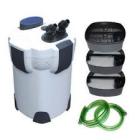| Back to Back Issues Page |
 |
|
The Goldfish Gazette, Issue #005 -- Aquarium Filters - Choosing The Right One May 31, 2014 |
Goldfish Care Tips and GuidelinesA Free Monthly Resource For Goldfish Enthusiasts In this issue With the large number of options available in today's market, you need to choose which option is best for you while keeping a wary eye on quality. Aquarium Filters - Choosing The Right One
Most assume the job of aquarium filters is to filter the aquarium water. The primary job of a filter is to circulate water through a colony of beneficial bacteria that convert aquarium waste to harmless compounds. The secondary purpose of a filter is to provide a limited amount of filtering of solids from the water. This secondary function is very limited. As an example, a standard filter can't filter out suspended green algae because the algae are too small to get caught in the filter media, and the bacteria don't feed on the algae.
Choosing the Correct Size FilterAs a general rule, a filter should circulate the aquarium water volume through itself twice an hour. In other words, a 100 gallon aquarium needs a filter that has a water flow of 200 gallons an hour. Most filters have a label stating their water flow per hour in liters or gallons. I tend to halve the quoted water flow figures when buying filters, as this is the usual loss of filtering efficiency once the filter is established. A filter that is the correct size for an aquarium shouldn't have to be cleaned out because of clogging more than 2-3 times a year. Undergravel filters are hard to estimate how much water is flowing if you aren't using powerheads. Types Of FiltersGenerally, the smaller your setup is, the less options you have, or at least, the less filter media options you have. Smaller filters generally use sponge inserts, and have little or no room for additional media such as activated charcoal. For aquariums up to say 15 gallons (around 70 liters), you can use internal box filters, undergravel filters, external hanging filters or a small internal power filter. For larger setups, if the goldish aren't too large, undergravel filters are an option, but the ideal filter for larger setups is the external canister type shown above. Quality Is a ProblemOn cheaper air lift type filters, check where the air line connects to the filter that it is robust enough for the job. Some canister filters coming out of Asia are poorly finished, especially where the sealing "O" ring seats. Advantages and DisadvantagesEach filter has its good and bad points.Go to the website where it lists them for the more common types of filters. Read more... Comments? Ideas? Feedback? I'd love to hear from you. Just reply to this e-zine and tell me what you think, or what topics you want covered. Next Month’s Topic Aquarium filter media - what makes your filter work. |
| Back to Back Issues Page |